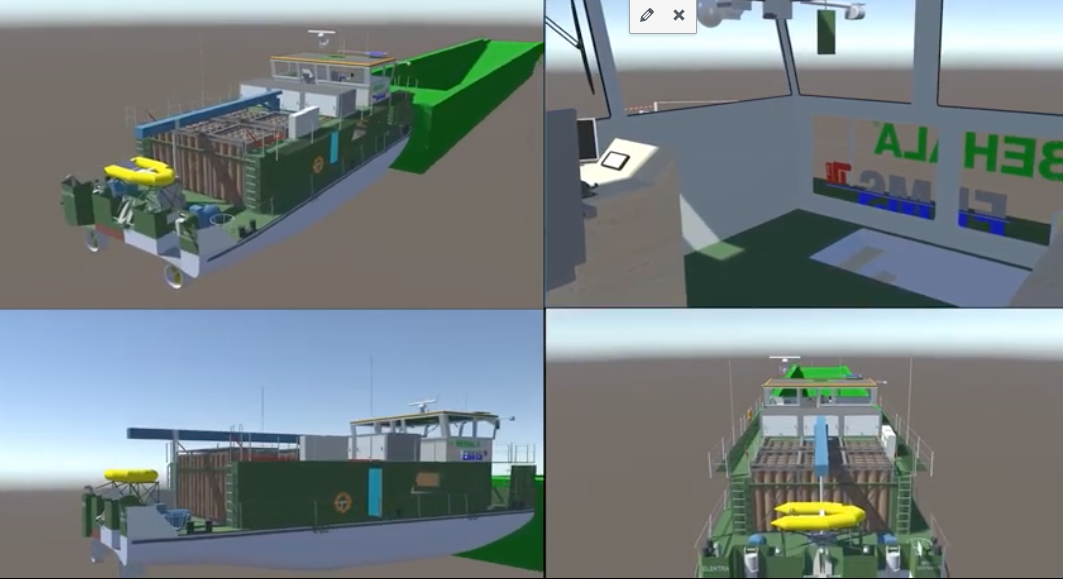
In the New Deal that the maritime transport sector concluded last year with the Dutch Minister Van Nieuwenhuizen of Infrastructure and Water Management, it was agreed, among other things, that inland shipping would be emission-free and climate-neutral by 2050. To achieve this goal, the electrically powered pusher craft ELEKTRA could play a major role. The Technical University of Berlin, together with a number of other institutions, is developing this ship to be equipped with hydrogen generators. The ELEKTRA will be launched this year and will initially commute between Hamburg and Berlin, later also calling at Stettin, Poland. The pusher is 20 meters long and 8.2 meters wide and is capable of pushing one single barge.
Inland navigation is already a relatively clean way of transporting goods. An average ship emits up to six times less CO2 than a truck. By far the least amount of emission per t/km is the bulk transport of a 6-barge pushed convoy. With the propulsion of one pusher, a cargo of 16,000 tons can be transported. (Source: Inland shipping figures).
Prof. Gerd Holbach of the Technical University of Berlin told Innovation Origins about this leading project to electrify inland navigation.
“The aim of the project,” says Holbach, ”is to test the hydrogen and fuel cell technology on board a ship. This should lead to further insight into how inland navigation can be assisted in emission-free propulsion. The hybrid propulsion concept consists of fuel cells and accumulators. With this project we want to demonstrate the feasibility of hydrogen as a direct or indirect energy source for shipping, bearing in mind all its specific requirements.
Development of bunkering infrastructure
In addition, we are developing concepts for the infrastructure. This ship also has to bunker, which involves charging the batteries with shore power and supplying the fuel cells with hydrogen. The infrastructure of the Western Harbor (Westhafen) port of Berlin is already sufficient for the initial use on the Berlin-Hamburg route. Hydrogen supply, in particular, can be achieved quickly and economically because there is no classic bunkering process. The containers of hydrogen can be quickly exchanged using the company’s own ship’s crane. In principle, this can be done at any quay.
Obtaining approval for shipping use of necessary components
One of the basic requirements of the ELEKTRA project was to use standard components as much as possible and to avoid developing a custom design for this specific purpose. This would have been far too expensive and impossible within the given timeframe. The practical use of the technology and the interaction between the components had to be tested on board. Virtually none of the required components had been approved specifically for maritime use, making it necessary to obtain approval and to align the components for the first time. This has never happened before.
The ELEKTRA is powered by two 200-kilowatt electric motors. These draw their energy from a huge battery pack that can store 3.2 megawatt hours. That block is located behind the wheelhouse. There are also six containers with a total of 750 kilos of hydrogen under a pressure of 500 bar. They feed the fuel cells, each with a capacity of 100 kilowatts. These supply power when the batteries are in danger of running out. Solar collectors have also been installed on the roof of the wheelhouse.

Range of pusher craft more than 400 kilometers
“Basically, the fuel cells provide the ship’s propulsion. The accumulators can be used to cope with peak loads. The three fuel cells can be operated independently of each other so that they can always function optimally. In principle, the ship can also sail solely on batteries. This is mainly an option for short distances. The ship can travel more than 400 km without taking on new energy at a thrust load of 1,500 tons. Hydrogen is absolutely the chief energy source for both energy systems.
Sailing assistant for optimal use of energy and route conditions
In addition to a completely new energy system for pusher craft, TU Berlin is also developing a special navigation system. This navigation assistant, says Holbach, “is clearly more than just a kind of TomTom for shipping. It is a combination of a navigation system and an on-board computer, just like in cars, except that in this case the systems communicate with each other. The system on the ELEKTRA takes into account environmental data (currents, wind, ice shifts, and temperatures), ship-specific data such as draught and displacement of the convoy in question, energy storage battery levels and resistance. These data are used to steer the ship as favorably as possible in terms of energy consumption and costs. However, the system not only assists the skipper, but also provides information to the onshore logistics department so that subsequent transports can be planned very accurately.
Hybrid system ready for the market at the end of this decade
Holbach expects the innovative accumulator and fuel cell system to be market-ready by the end of the decade. It will then have been demonstrated that this propulsion system works for inland vessels. “During the practical test with the ELEKTRA, we also want to obtain data on issues such as life cycle costs and other economic preconditions.”
You can read other IO articles on the greening of shipping via this link

